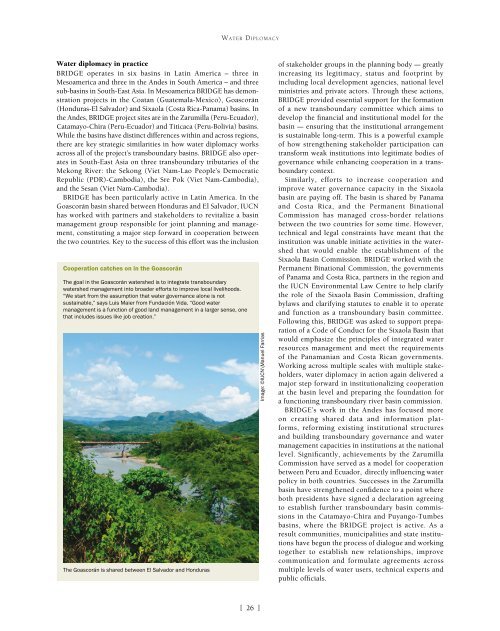Free Flow
oJhBl
oJhBl
You also want an ePaper? Increase the reach of your titles
YUMPU automatically turns print PDFs into web optimized ePapers that Google loves.
Water Diplomacy<br />
Water diplomacy in practice<br />
BRIDGE operates in six basins in Latin America – three in<br />
Mesoamerica and three in the Andes in South America – and three<br />
sub-basins in South-East Asia. In Mesoamerica BRIDGE has demonstration<br />
projects in the Coatan (Guatemala-Mexico), Goascorán<br />
(Honduras-El Salvador) and Sixaola (Costa Rica-Panama) basins. In<br />
the Andes, BRIDGE project sites are in the Zarumilla (Peru-Ecuador),<br />
Catamayo-Chira (Peru-Ecuador) and Titicaca (Peru-Bolivia) basins.<br />
While the basins have distinct differences within and across regions,<br />
there are key strategic similarities in how water diplomacy works<br />
across all of the project’s transboundary basins. BRIDGE also operates<br />
in South-East Asia on three transboundary tributaries of the<br />
Mekong River: the Sekong (Viet Nam-Lao People’s Democratic<br />
Republic (PDR)-Cambodia), the Sre Pok (Viet Nam-Cambodia),<br />
and the Sesan (Viet Nam-Cambodia).<br />
BRIDGE has been particularly active in Latin America. In the<br />
Goascorán basin shared between Honduras and El Salvador, IUCN<br />
has worked with partners and stakeholders to revitalize a basin<br />
management group responsible for joint planning and management,<br />
constituting a major step forward in cooperation between<br />
the two countries. Key to the success of this effort was the inclusion<br />
Cooperation catches on in the Goascorán<br />
The goal in the Goascorán watershed is to integrate transboundary<br />
watershed management into broader efforts to improve local livelihoods.<br />
“We start from the assumption that water governance alone is not<br />
sustainable,” says Luis Maier from Fundación Vida. “Good water<br />
management is a function of good land management in a larger sense, one<br />
that includes issues like job creation.”<br />
The Goascorán is shared between El Salvador and Honduras<br />
Image: ©IUCN\Manuel Farrias<br />
of stakeholder groups in the planning body – greatly<br />
increasing its legitimacy, status and footprint by<br />
including local development agencies, national level<br />
ministries and private actors. Through these actions,<br />
BRIDGE provided essential support for the formation<br />
of a new transboundary committee which aims to<br />
develop the financial and institutional model for the<br />
basin – ensuring that the institutional arrangement<br />
is sustainable long-term. This is a powerful example<br />
of how strengthening stakeholder participation can<br />
transform weak institutions into legitimate bodies of<br />
governance while enhancing cooperation in a transboundary<br />
context.<br />
Similarly, efforts to increase cooperation and<br />
improve water governance capacity in the Sixaola<br />
basin are paying off. The basin is shared by Panama<br />
and Costa Rica, and the Permanent Binational<br />
Commission has managed cross-border relations<br />
between the two countries for some time. However,<br />
technical and legal constraints have meant that the<br />
institution was unable initiate activities in the watershed<br />
that would enable the establishment of the<br />
Sixaola Basin Commission. BRIDGE worked with the<br />
Permanent Binational Commission, the governments<br />
of Panama and Costa Rica, partners in the region and<br />
the IUCN Environmental Law Centre to help clarify<br />
the role of the Sixaola Basin Commission, drafting<br />
bylaws and clarifying statutes to enable it to operate<br />
and function as a transboundary basin committee.<br />
Following this, BRIDGE was asked to support preparation<br />
of a Code of Conduct for the Sixaola Basin that<br />
would emphasize the principles of integrated water<br />
resources management and meet the requirements<br />
of the Panamanian and Costa Rican governments.<br />
Working across multiple scales with multiple stakeholders,<br />
water diplomacy in action again delivered a<br />
major step forward in institutionalizing cooperation<br />
at the basin level and preparing the foundation for<br />
a functioning transboundary river basin commission.<br />
BRIDGE’s work in the Andes has focused more<br />
on creating shared data and information platforms,<br />
reforming existing institutional structures<br />
and building transboundary governance and water<br />
management capacities in institutions at the national<br />
level. Significantly, achievements by the Zarumilla<br />
Commission have served as a model for cooperation<br />
between Peru and Ecuador, directly influencing water<br />
policy in both countries. Successes in the Zarumilla<br />
basin have strengthened confidence to a point where<br />
both presidents have signed a declaration agreeing<br />
to establish further transboundary basin commissions<br />
in the Catamayo-Chira and Puyango-Tumbes<br />
basins, where the BRIDGE project is active. As a<br />
result communities, municipalities and state institutions<br />
have begun the process of dialogue and working<br />
together to establish new relationships, improve<br />
communication and formulate agreements across<br />
multiple levels of water users, technical experts and<br />
public officials.<br />
[ 26 ]


